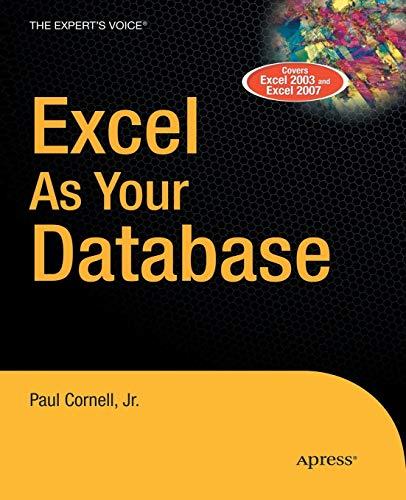Answered step by step
Verified Expert Solution
Question
1 Approved Answer
510 CHAPTER 9 Graphic illustrations CHECK YOUR COMPREHENSION After reading the selection, answer the following questions with a, b, c, ord. To help you analyze
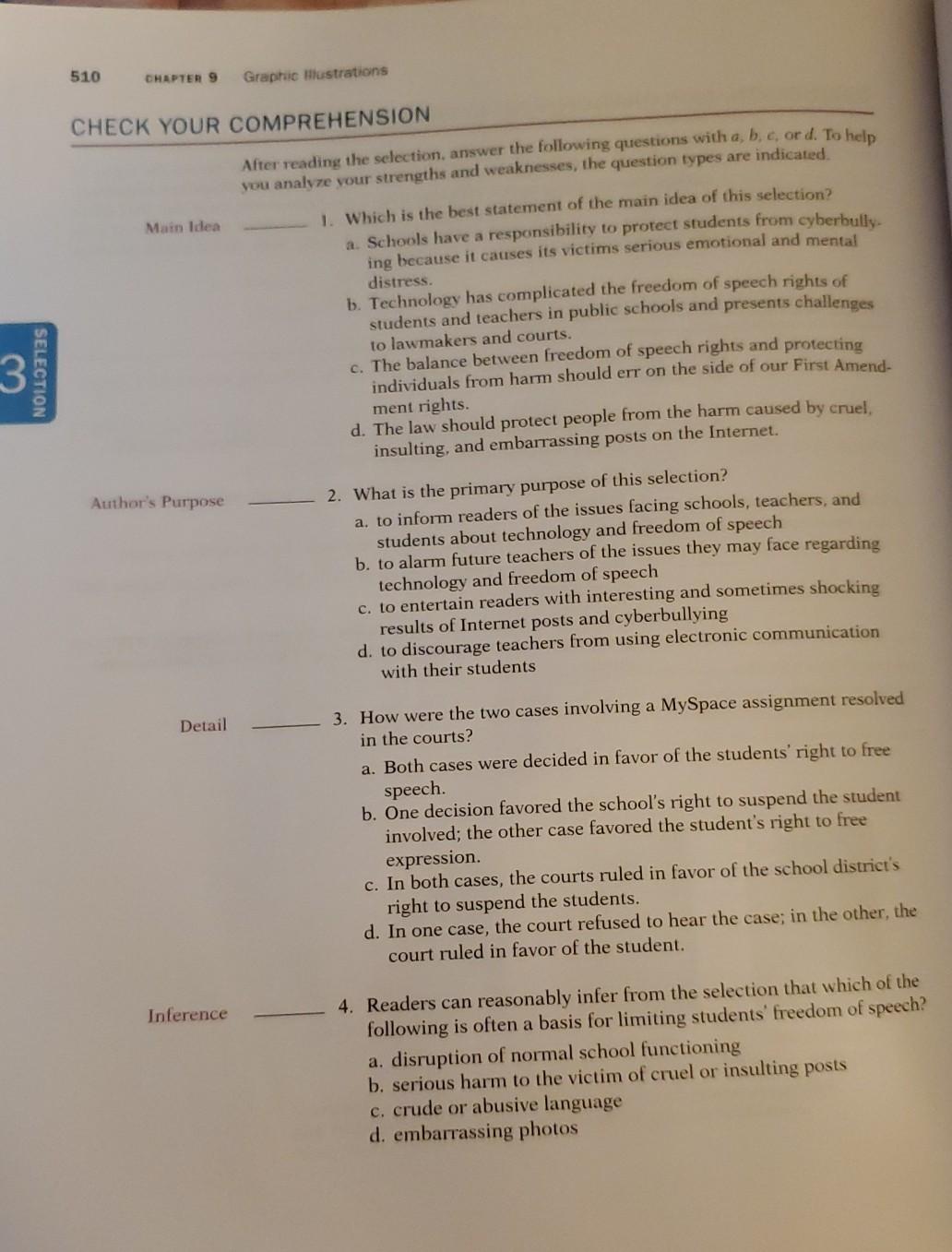
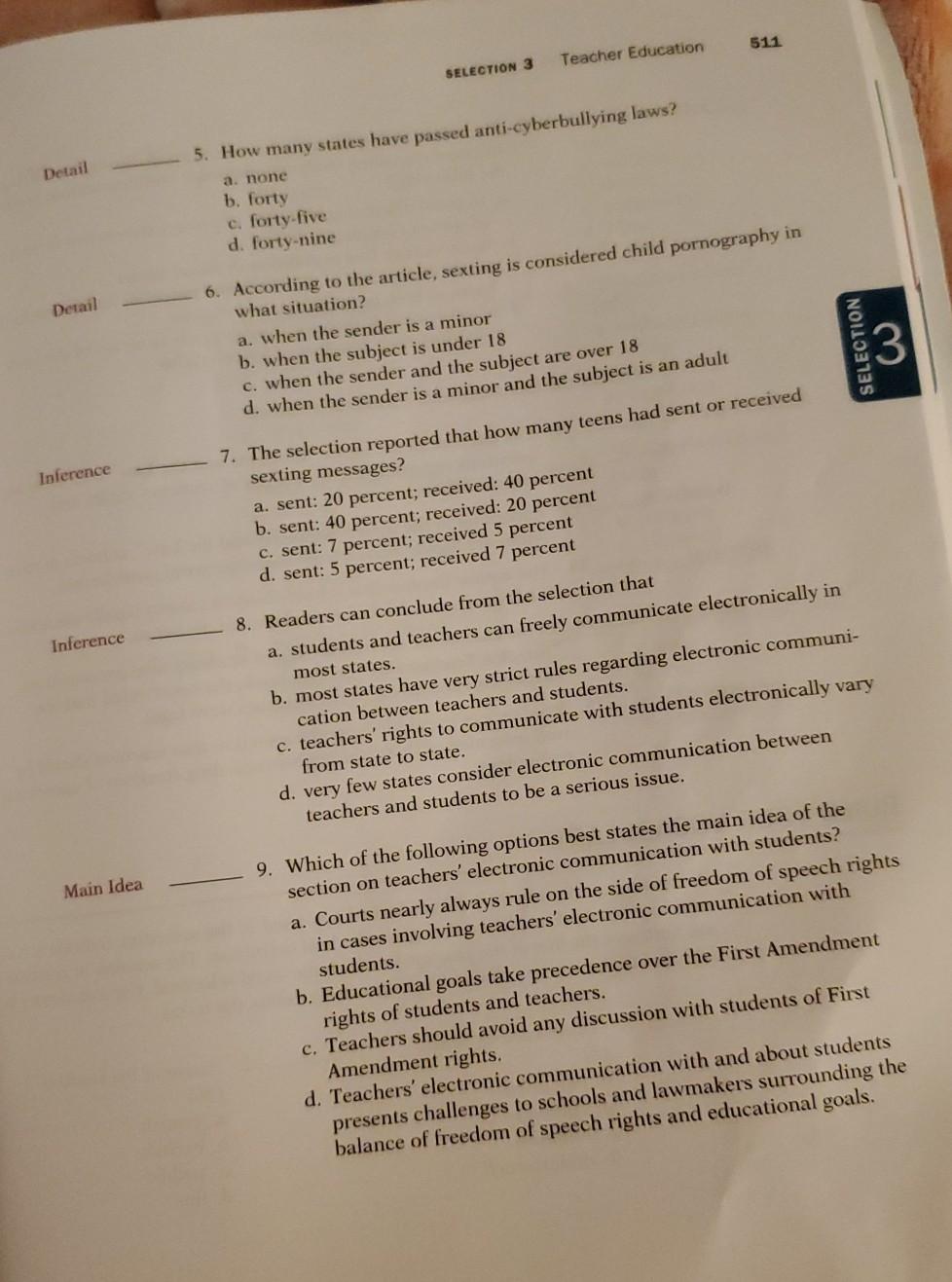
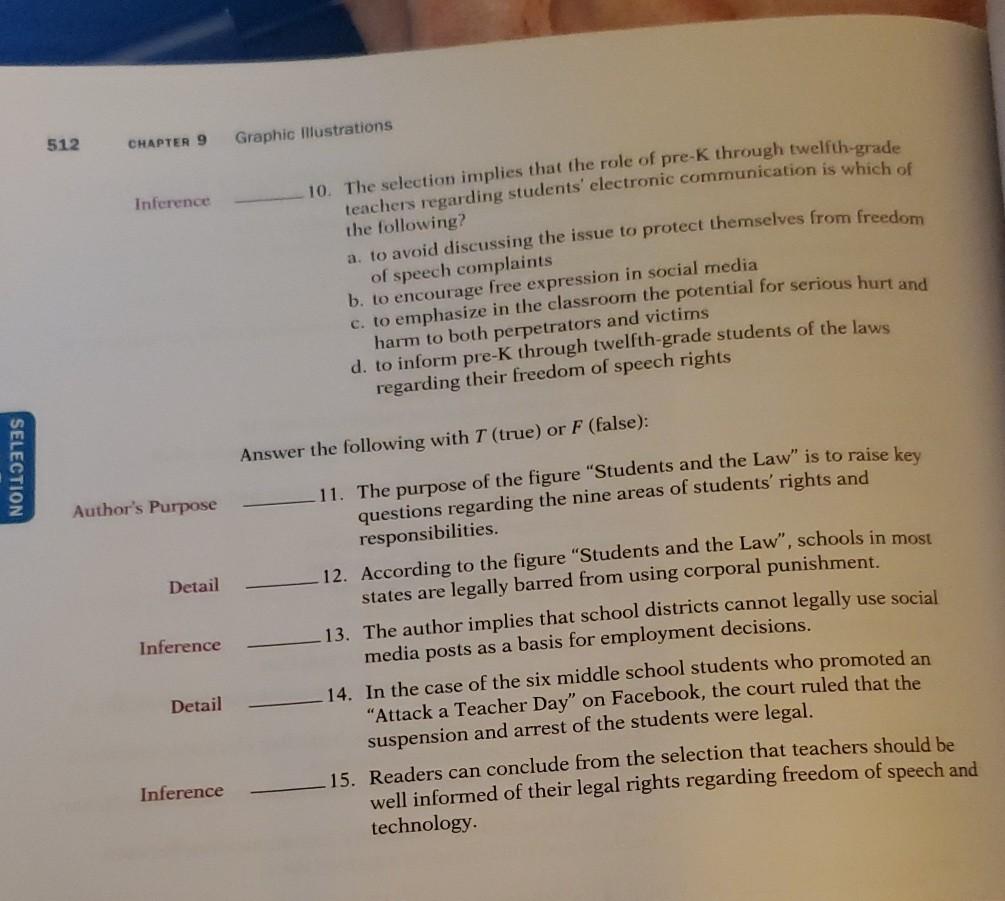
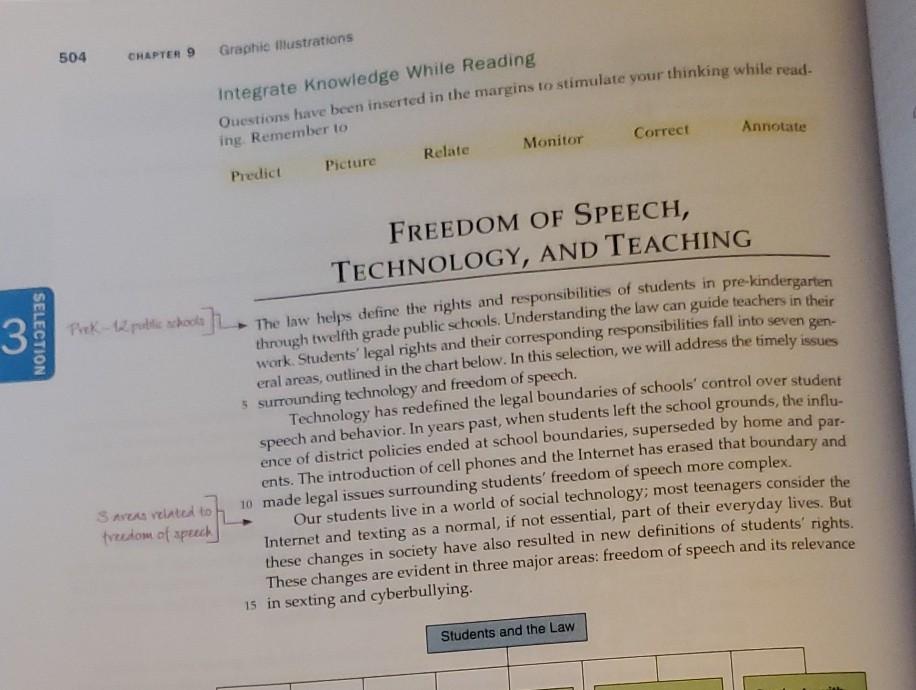

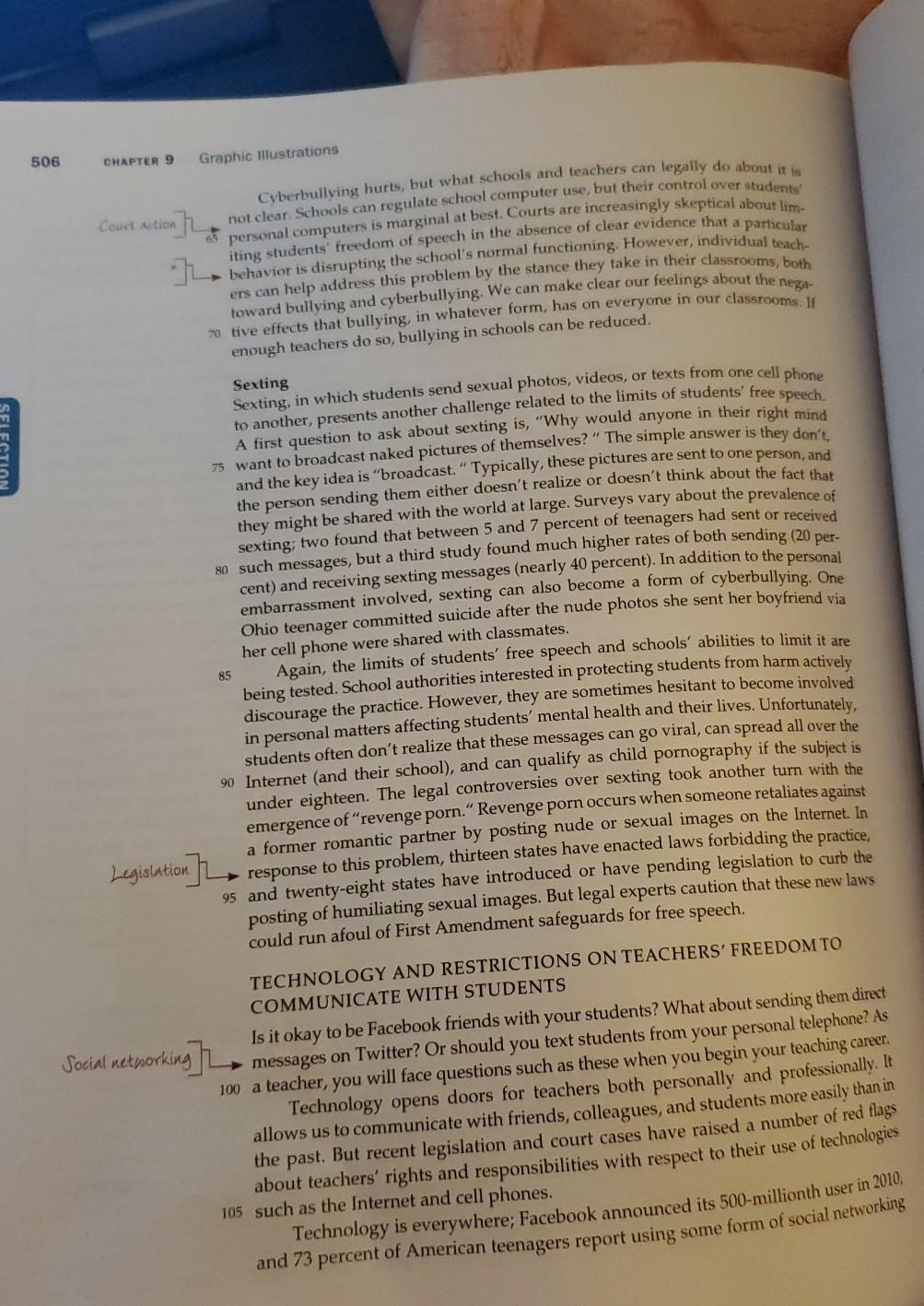
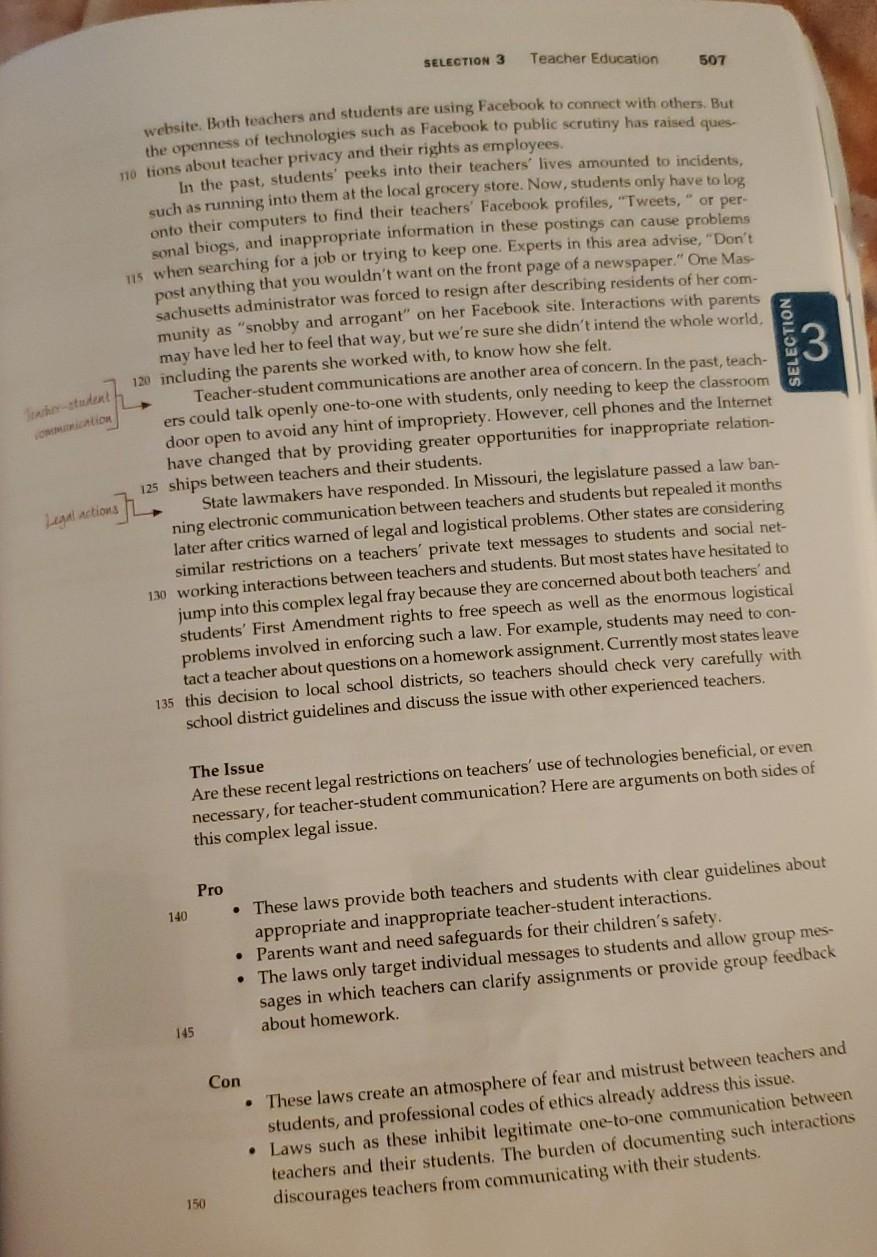
510 CHAPTER 9 Graphic illustrations CHECK YOUR COMPREHENSION After reading the selection, answer the following questions with a, b, c, ord. To help you analyze your strengths and weaknesses, the question types are indicated Main Idea 1. Which is the best statement of the main idea of this selection? a Schools have a responsibility to protect students from cyberbully ing because it causes its victims serious emotional and mental distress. b. Technology has complicated the freedom of speech rights of students and teachers in public schools and presents challenges to lawmakers and courts. c. The balance between freedom of speech rights and protecting individuals from harm should err on the side of our First Amend- ment rights. d. The law should protect people from the harm caused by cruel, insulting, and embarrassing posts on the Internet. 3 SELECTION Author's Purpose 2. What is the primary purpose of this selection? a. to inform readers of the issues facing schools, teachers, and students about technology and freedom of speech b. to alarm future teachers of the issues they may face regarding technology and freedom of speech c. to entertain readers with interesting and sometimes shocking results of Internet posts and cyberbullying d. to discourage teachers from using electronic communication with their students Detail 3. How were the two cases involving a MySpace assignment resolved in the courts? a. Both cases were decided in favor of the students' right to free speech. b. One decision favored the school's right to suspend the student involved; the other case favored the student's right to free expression. c. In both cases, the courts ruled in favor of the school district's right to suspend the students. d. In one case, the court refused to hear the case; in the other, the court ruled in favor of the student. Inference 4. Readers can reasonably infer from the selection that which of the following is often a basis for limiting students freedom of speech? a. disruption of normal school functioning b. serious harm to the victim of cruel or insulting posts c. crude or abusive language d. embarrassing photos 511 Teacher Education SELECTION 3 Detail Detail 5. How many states have passed anti-cyberbullying laws? a. none b. forty c. forty-five d. forty-nine 6. According to the article, sexting is considered child pornography in what situation? a. when the sender is a minor b. when the subject is under 18 c. when the sender and the subject are over 18 d. when the sender is a minor and the subject is an adult 7. The selection reported that how many teens had sent or received sexting messages? a. sent: 20 percent; received: 40 percent b. sent: 40 percent; received: 20 percent c. sent: 7 percent; received 5 percent d. sent: 5 percent; received 7 percent SELECTION Inference Inference 8. Readers can conclude from the selection that a. students and teachers can freely communicate electronically in most states. b. most states have very strict rules regarding electronic communi- cation between teachers and students. c. teachers' rights to communicate with students electronically vary from state to state. d. very few states consider electronic communication between teachers and students to be a serious issue. Main Idea 9. Which of the following options best states the main idea of the section on teachers' electronic communication with students? a. Courts nearly always rule on the side of freedom of speech rights in cases involving teachers' electronic communication with students. b. Educational goals take precedence over the First Amendment rights of students and teachers. c. Teachers should avoid any discussion with students of First Amendment rights. d. Teachers' electronic communication with and about students presents challenges to schools and lawmakers surrounding the balance of freedom of speech rights and educational goals. 512 CHAPTER 9 Graphic Illustrations Inference 10. The selection implies that the role of pre-K through twelfth-grade teachers regarding students' electronic communication is which of the following? a. to avoid discussing the issue to protect themselves from freedom of speech complaints b. to encourage free expression in social media c. to emphasize in the classroom the potential for serious hurt and harm to both perpetrators and victims d. to inform pre-K through twelfth-grade students of the laws regarding their freedom of speech rights SELECTION Answer the following with T (true) or F (false): Author's Purpose Detail Inference 11. The purpose of the figure "Students and the Law" is to raise key questions regarding the nine areas of students' rights and responsibilities. 12. According to the figure "Students and the Law", schools in most states are legally barred from using corporal punishment. 13. The author implies that school districts cannot legally use social media posts as a basis for employment decisions. 14. In the case of the six middle school students who promoted an "Attack a Teacher Day" on Facebook, the court ruled that the suspension and arrest of the students were legal. 15. Readers can conclude from the selection that teachers should be well informed of their legal rights regarding freedom of speech and technology. Detail Inference 504 CHAPTER 9 Graphie illustrations Integrate knowledge While Reading Questions have been inserted in the margins to stimulate your thinking while read. ing. Remember to Annotate Correct Monitor Relate Picture Predict 3 SELECTION Pack 12 pottic schools FREEDOM OF SPEECH, TECHNOLOGY, AND TEACHING The law helps define the rights and responsibilities of students in pre-kindergarten through twelfth grade public schools. Understanding the law can guide teachers in their work. Students' legal rights and their corresponding responsibilities fall into seven gen- eral areas, outlined in the chart below. In this selection, we will address the timely issues 5 surrounding technology and freedom of speech Technology has redefined the legal boundaries of schools' control over student speech and behavior. In years past, when students left the school grounds, the influ- ence of district policies ended at school boundaries, superseded by home and par- ents. The introduction of cell phones and the Internet has erased that boundary and 10 made legal issues surrounding students' freedom of speech more complex. Our students live in a world of social technology; most teenagers consider the Internet and texting as a normal, if not essential, part of their everyday lives. But these changes in society have also resulted in new definitions of students' rights. These changes are evident in three major areas: freedom of speech and its relevance 15 in sexting and cyberbullying. Sareas related to freedom of speech Students and the Law SELECTION 3 Teacher Education 505 STUDENTS' FREEDOM OF SPEECH 20 Students' freedom of speech is protected by the First Amendment, but what hap- pens when students' electronic messages hurt others or disrupt school functioning? Two court cases illustrate the complexity of the issues. See the first box titled Two Court Cases Students in two different Pennsylvania schools created mock MySpace profiles featuring profiles of their principals. Both contained outrageous and unbelievable statements about the principals (e.g., one called the principal a "big whore," and "sex addict," and the other claimed the Conditions SELECTION who at the time thought this was pretty "Two Court Cases." What would you do if you were the judge on these cases? Interestingly, separate courts deliv- ered two different opinions. One U.S. Circuit Court of Appeals con- 25 cluded that the schools could legally suspend the students because these actions were neces- sary to preserve the principal's principal was a "big marijuana-smoking authority and avert future disrup- steroid freak"). Students in both incidents, 30 tions. The other court reached just the opposite conclusion, protecting funny, were suspended and subsequently the student's First Amendment took their cases to court, claiming their rights and asserting that the school First Amendment rights were violated. had failed to prove that the posting 35 had significantly disrupted the teaching environment. These contradictory rulings confirm that the whole issue of student freedom of speech on the Internet is cur- rently murky, uncertain territory. A third case involving electronic The Third Court Case freedom of speech focused on the Six middle school girls in Nevada posted 40 issue of school safety. See the second an "Attack a Teacher Day" message on a box titled "The Third Court Case." Facebook page. The students claimed it The ultimate outcomes of legal was just meant as a joke, but they were actions in this case were still being suspended from school and arrested on worked out in the courts at the time the same day that a teenage student in 45 this edition of your book was pub- Omaha, Nebraska, fatally shot an assis- lished, but they point to the com- tant principle, wounded the principal, plexities of issues surrounding the and then took his own life. incidents. Can schools control the contents of students' private e-mail messages, and what are the limits to students 50 freedom of speech? Future court decisions will help answer these questions, Court Action Cyberbullying Bullying has always been a problem in our schools, but technology has added a new dimension to the problem. One informal poll of seventh graders revealed that 45 percent had been cyberbullied. Adjectives like "ho," "skank," and "fat bitch," appear frequently in students' postings about other students, and both parents and 55 school officials are taking action. Cyberbullying becomes a serious problem when it places other students' mental health or lives at risk. Cyberbullying has caught the attention of state lawmakers, with forty-nine states passing anti-cyberbullying laws. In a well-publicized case of cyberbullying involving a gay college student, a roommate secretly videotaped a homosexual encounter and posted the video on the 60 Internet. The student was so devastated by the "outing" that he committed suicide by jumping off a bridge 200 feet into the Hudson River. Other cyberbullying inci- dents at the middle and high school levels have resulted in similar teen suicides. 506 CHAPTER 9 Graphic Illustrations not clear Schools can regulate school computer use, but their control over students' Court Action iting students' freedom of speech in the absence of clear evidence that a particular behavior is disrupting the school's normal functioning. However, individual teach ers can help address this problem by the stance they take in their classrooms, both toward bullying and cyberbullying. We can make clear our feelings about the nega 70 tive effects that bullying, in whatever form, has on everyone in our classrooms. enough teachers do so, bullying in schools can be reduced. SELECTION Sexting Sexting, in which students send sexual photos, videos, or texts from one cell phone to another, presents another challenge related to the limits of students free speech 75 want to broadcast naked pictures of themselves?" The simple answer is they don't and the key idea is "broadcast." Typically, these pictures are sent to one person, and the person sending them either doesn't realize or doesn't think about the fact that they might be shared with the world at large. Surveys vary about the prevalence of sexting; two found that between 5 and 7 percent of teenagers had sent or received 80 such messages, but a third study found much higher rates of both sending (20 per- cent) and receiving sexting messages (nearly 40 percent). In addition to the personal embarrassment involved, sexting can also become a form of cyberbullying. One Ohio teenager committed suicide after the nude photos she sent her boyfriend via her cell phone were shared with classmates. Again, the limits of students' free speech and schools' abilities to limit it are being tested. School authorities interested in protecting students from harm actively discourage the practice. However, they are sometimes hesitant to become involved in personal matters affecting students' mental health and their lives. Unfortunately, students often don't realize that these messages can go viral, can spread all over the 90 Internet (and their school), and can qualify as child pornography if the subject is under eighteen. The legal controversies over sexting took another turn with the emergence of revenge porn." Revenge porn occurs when someone retaliates against a former romantic partner by posting nude or sexual images on the Internet . In response to this problem, thirteen states have enacted laws forbidding the practice, 95 and twenty-eight states have introduced or have pending legislation to curb the posting of humiliating sexual images. But legal experts caution that these new laws could run afoul of First Amendment safeguards for free speech. 85 Legislation TECHNOLOGY AND RESTRICTIONS ON TEACHERS' FREEDOM TO COMMUNICATE WITH STUDENTS Social networking Is it okay to be Facebook friends with your students? What about sending them direct messages on Twitter? Or should you text students from your personal telephone? As 100 a teacher, you will face questions such as these when you begin your teaching career. Technology opens doors for teachers both personally and professionally. It allows us to communicate with friends, colleagues, and students more easily than in the past. But recent legislation and court cases have raised a number of red flags about teachers' rights and responsibilities with respect to their use of technologies 105 such as the Internet and cell phones. Technology is everywhere; Facebook announced its 500-millionth user in 2010, and 73 percent of American teenagers report using some form of social networking SELECTION 3 Teacher Education 507 SELECTION 3 httex Oication website. Both teachers and students are using Facebook to connect with others. But the openness of technologies such as Facebook to public scrutiny has raised ques no tions about teacher privacy and their rights as employees. In the past, students' peeks into their teachers' lives amounted to incidents, such as running into them at the local grocery store. Now, students only have to log onto their computers to find their teachers' Facebook profiles, "Tweets, or per sonal biogs, and inappropriate information in these postings can cause problems 115 when searching for a job or trying to keep one. Experts in this area advise, "Don't post anything that you wouldn't want on the front page of a newspaper." One Mas- sachusetts administrator was forced to resign after describing residents of her com- munity as "snobby and arrogant" on her Facebook site. Interactions with parents may have led her to feel that way, but we're sure she didn't intend the whole world, 120 including the parents she worked with, to know how she felt. Teacher-student communications are another area of concern. In the past, teach- ers could talk openly one-to-one with students, only needing to keep the classroom door open to avoid any hint of impropriety. However, cell phones and the Internet have changed that by providing greater opportunities for inappropriate relation- 125 ships between teachers and their students. State lawmakers have responded. In Missouri, the legislature passed a law ban ning electronic communication between teachers and students but repealed it months later after critics warned of legal and logistical problems. Other states are considering similar restrictions on a teachers' private text messages to students and social net- 1:30 working interactions between teachers and students. But most states have hesitated to jump into this complex legal fray because they are concerned about both teachers' and students' First Amendment rights to free speech as well as the enormous logistical problems involved in enforcing such a law. For example, students may need to con- tact a teacher about questions on a homework assignment. Currently most states leave 135 this decision to local school districts, so teachers should check very carefully with school district guidelines and discuss the issue with other experienced teachers. 72 Les actions The Issue Are these recent legal restrictions on teachers' use of technologies beneficial, or even necessary, for teacher-student communication? Here are arguments on both sides of this complex legal issue. 140 Pro These laws provide both teachers and students with clear guidelines about appropriate and inappropriate teacher-student interactions. Parents want and need safeguards for their children's safety. The laws only target individual messages to students and allow group mes- sages in which teachers can clarify assignments or provide group feedback about homework. 145 Con These laws create an atmosphere of fear and mistrust between teachers and students, and professional codes of ethics already address this issue. Laws such as these inhibit legitimate one-to-one communication between teachers and their students. The burden of documenting such interactions discourages teachers from communicating with their students. 150
Step by Step Solution
There are 3 Steps involved in it
Step: 1

Get Instant Access to Expert-Tailored Solutions
See step-by-step solutions with expert insights and AI powered tools for academic success
Step: 2

Step: 3

Ace Your Homework with AI
Get the answers you need in no time with our AI-driven, step-by-step assistance
Get Started


